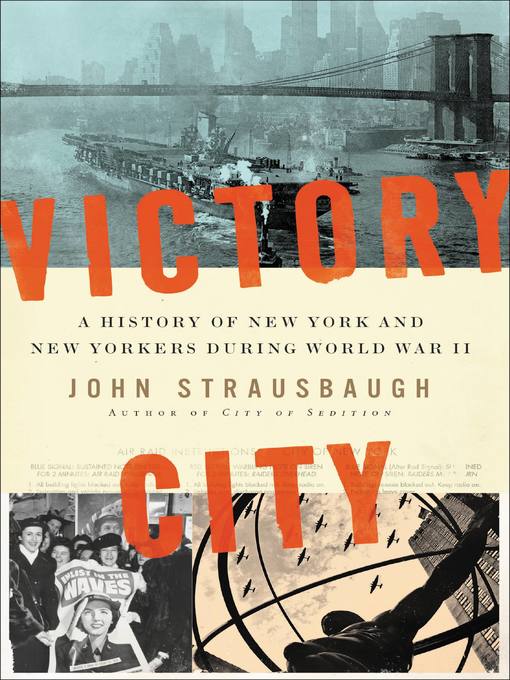
Victory City
A History of New York and New Yorkers during World War II
- اطلاعات
- نقد و بررسی
- دیدگاه کاربران
نقد و بررسی

October 1, 2018
From teenagers in zoot suits and bobby socks to New York–bred Soviet moles infiltrating the Manhattan Project and German U-boats lurking off the city’s shoreline, Strausbaugh (City of Sedition: A History of New York City during the Civil War) delivers a lively chronicle of New York City during the 1930s and ’40s. Strausbaugh highlights New York’s influential role in the war effort due to its sheer size, defense and auxiliary organizations (among them, the Brooklyn Navy Yard and USO), and political and economic clout—President Franklin Roosevelt, a native New Yorker, filled his cabinet and administration with influential New Yorkers. Entertaining and episodic, Strausbaugh’s work explores the cultural changes precipitated by the rise of women in the workforce; the racial discrimination black service members faced in the military and at home that led to the 1943 Harlem Riot; the corporations and banks that hid under a patriotic front while investing in Hitler’s regime; and the New York Jewish community’s deep divisions over Roosevelt’s slow and ineffective response to the Holocaust. The narrative sweeps in New York City’s larger-than-life mayor Fiorello La Guardia, Nazi spies and saboteurs, atomic scientists, poets, and gangsters. This well-informed and vibrant history captures a pivotal era in deep detail.

October 1, 2018
Strausbaugh (City of Sedition: The History of New York During the Civil War, 2016, etc.) presents a panoramic view of a great city at the height of its power.In 1940, New York City was a demographic and cultural colossus; far more than today, what happened there mattered. It was the largest city in the world, its port was the busiest in the world, it employed more workers in manufacturing than any other city, and it was the nation's hub for merchandising, finance, media, theater, and fashion. The author, an expert on the history of New York, creates a suitably sprawling portrait of the city and its residents during the first half of the 20th century. Then, as now, it was a city of immigrants; it sometimes seems as though nearly everyone who lived there was, or was the child of, immigrants from central Europe with Anglicized names. In Strausbaugh's portrayal, Nazi and communist spies, mobsters and politicos rub elbows with Eleanor Roosevelt, zoot suiters, and bobby-soxers, Rosie the Riveter, war profiteers, and draft resisters, with the rumbustious mayor Fiorello LaGuardia roaring around throughout. Short chapters move the presentation briskly along; if one topic fails to engage, another will be along momentarily. The rapid pacing seems to mimic the frenetic energy of the city, while the familiar flow of the era's national and world events provides an orderly structure to the narrative. The parade of colorful anecdotes and character sketches, presented in a brash and sometimes sassy style, makes this an entertaining read. The author makes no claims to insightful social or historical revelation; the book is a pleasant visit to a confident and powerful city helping to lead its nation to victory in a global conflict, conducted by a witty and knowledgeable guide.A passionate love letter to a city and era that have long since faded away.
COPYRIGHT(2018) Kirkus Reviews, ALL RIGHTS RESERVED.

December 1, 2018
Longtime New York City chronicler Strausbaugh (City of Sedition) has put together an ambitious book detailing life in the Big Apple during World War II. While focusing on the years 1939-45, the author dedicates plenty of space to the decades preceding and following the war. In doing so, he places both New York and World War II in context, culturally and politically. Highlighting both major and minor cultural and political events, the work's brief chapters offer anecdotes of New Yorkers. At times it's hard to see how some of the people featured fit into the larger narrative of wartime New York, especially when they're only mentioned once. But overall the book is readable and compelling and isn't bogged down by these divergent stories. VERDICT While academics might find the broad scope unsatisfying, this is nonetheless a captivating and well-researched New York history bound to please anyone interested in World War II, New York, as well as general popular history readers.--Timothy Berge, West Virginia Univ., Morgantown
Copyright 2018 Library Journal, LLC Used with permission.

October 15, 2018
Strausbaugh has written about New York City before; his City of Sedition? (2016) was about the city and its citizens during the Civil War. Now he turns to WWII with another chatty, fact-filled popular narrative. Dealing briefly with the period preceding the war, Victory City opens with the New York World's Fair of 1939 and then turns to life in the city during the war. As with the previous book, Strausbaugh tells his story through a series of short portraits of sometimes unrelated individuals, from prominent figures like FDR and Fiorello LaGuardia, to virtually unknown women and men. Along with the tapestry of portraits, there is also more extended treatment of certain themes?espionage, for example, mainly that of pro-German groups during the war, but there is also reference to Soviet spies after the war, including the Rosenbergs. His coverage of New York Jews is also thorough and revealing, buffeted by discussion of the attempts to save European Jews. In some ways, the book strays from a purely New York focus, but it is a compelling read about a fascinatingly rich period.(Reprinted with permission of Booklist, copyright 2018, American Library Association.)




دیدگاه کاربران